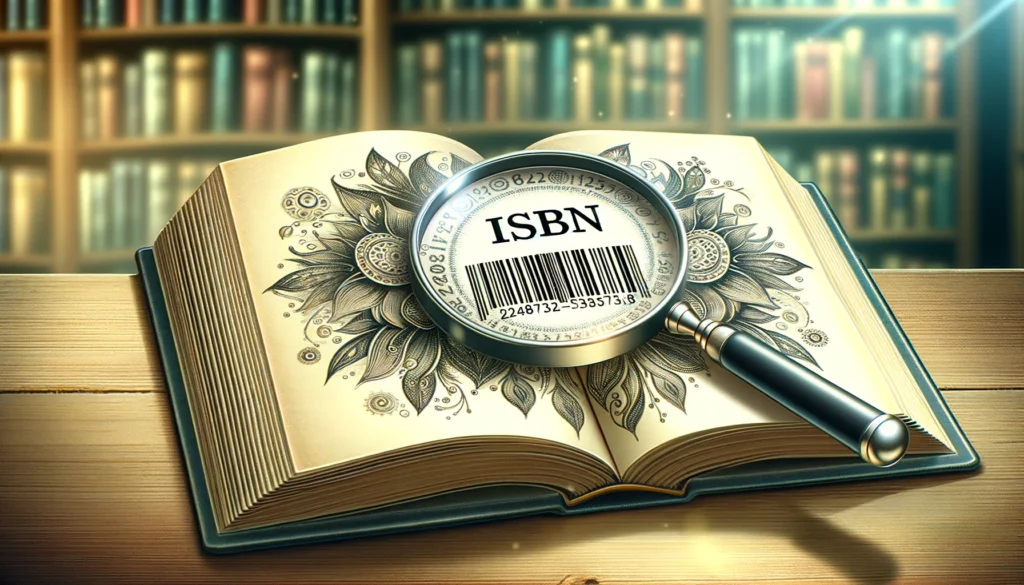If you’ve ever picked up a book and wondered about the string of numbers above the barcode, you’re looking at an ISBN. “What does ISBN stand for?” you might ask. It stands for International Standard Book Number, and it’s like a fingerprint for books, ensuring each title, edition, and format can be easily distinguished from one another.
Understanding the ISBN is essential for anyone involved in writing, publishing, or selling books. It’s not just a random set of digits; it’s a system designed to streamline the distribution and sale of books worldwide.
So, let’s dive into the world of ISBNs together. We’ll explore what they are, why they’re important, and how they help keep the world of books organized and accessible.
What Does ISBN Stand For

The term ISBN is an acronym that stands for International Standard Book Number. Essentially, it’s a unique identifier assigned to each published book and specific editions of a book, except for reprints.
This system was created to simplify the distribution and purchase of books across the globe.
An ISBN ensures that no two books (or editions) share the same number, making it easier for publishers, booksellers, libraries, and readers to find, order, and manage books without confusion.
An ISBN is typically a 13-digit number (formerly 10 digits before 2007), which is broken down into parts indicating the country or geographical region, the publisher, the title, and a check digit to verify the number’s accuracy.
This standardized approach helps streamline the process of book identification and sales tracking, contributing significantly to the efficiency of global book trade.
History of the ISBN
The concept of the ISBN originated in the United Kingdom in 1966, inspired by the need for a standardized system to categorize books in an increasingly complex market.
It was known as the Standard Book Numbering (SBN) system before it was adopted internationally.
In 1970, the International Organization for Standardization (ISO) officially adopted the system, and it became known as the ISBN.
The transition to a global standard was driven by the growing need for publishers, booksellers, and libraries worldwide to manage and exchange book information accurately and efficiently.
As the publishing industry expanded and the number of published titles exploded, the ISBN became an indispensable tool for organizing and navigating the sea of literature.
The system’s introduction marked a significant milestone in the publishing world, facilitating smoother operations in book retail and library systems and ensuring that books could be easily identified and tracked on a global scale.
How ISBNs Are Used

ISBNs serve as more than just numerical sequences on the back of books. They’re highly important in the lifecycle of a book from publication to purchase.
Firstly, ISBNs make it possible to identify a book’s specific edition, which is crucial for sales, distribution, and stocking.
Whether a book is hardcover, paperback, or an e-book, each version gets its own ISBN, allowing for precise tracking in sales data and inventory systems.
This unique identification aids in the efficient management of bookstore and library inventories, ensuring that the correct edition is ordered and stocked.
For publishers, ISBNs are instrumental in compiling and analyzing sales information, enabling targeted marketing strategies and distribution plans.
Moreover, ISBNs facilitate the discovery of books by readers through various online and offline cataloging systems, enhancing visibility and accessibility in a crowded market.
Structure of an ISBN
Understanding the structure of an ISBN can seem like decoding a secret message, but it’s quite systematic.
A current ISBN consists of 13 digits, divided into five parts, each separated by hyphens. These parts include:
- Prefix: Currently, this is either 978 or 979, indicating the book publishing sector.
- Registration Group Element: This identifies the country, geographical region, or language area of the publisher.
- Registrant Element: This part identifies the specific publisher. The length varies, indicating the publisher’s size (more books published equals a shorter registrant element).
- Publication Element: This segment represents the specific edition and format of the book.
- Check Digit: The final digit is a mathematical sum of the other digits, used to validate the ISBN.
Each segment of the ISBN plays a specific role in categorizing the book, making it a powerful tool for tracking and managing books on a global scale.
The system’s design ensures that each book can be uniquely identified, simplifying numerous aspects of the publishing and retail process.
Obtaining an ISBN

Getting an ISBN is a crucial step for publishers and self-published authors alike, as it officially enters the book into the global marketplace.
The process for obtaining an ISBN can vary slightly by country, but the basic steps are universally similar.
For traditional publishers, obtaining an ISBN is part of their standard publishing process.
They usually have blocks of ISBNs purchased from the national ISBN agency, and they assign these numbers to new books as part of their production workflow.
Self-published authors have a slightly different path. Here’s a general outline of what they need to do:
- Contact the National ISBN Agency: Authors should start by contacting the ISBN agency in their country. You can find a list of these agencies on the International ISBN Agency’s website. Each country has its own agency responsible for assigning ISBNs within its jurisdiction.
- Apply for an ISBN: The application process usually involves filling out a form (either online or on paper) and providing information about your book, such as the title, author name, and publication date. You’ll also need to indicate how many ISBNs you require. For self-publishers, a single ISBN may suffice, but it’s worth considering future editions or formats of your book.
- Pay the Fee: There is typically a fee associated with obtaining an ISBN. This fee can vary depending on the country and the number of ISBNs you’re applying for. Some countries offer the service for free, while others may charge.
- Receive Your ISBN: Once your application is processed and the fee is paid, you’ll receive your ISBN(s). This number should then be included in your book’s design, typically on the back cover near the barcode and on the copyright page.
It’s important for self-published authors to remember that while some self-publishing platforms, like Amazon KDP, offer to provide an ISBN for your book, this might mean the platform is listed as the publisher.
If you want full control and ownership, it’s best to obtain your own ISBN directly.
By securing an ISBN, authors and publishers ensure their books are recognized and accessible in the global book market, making it easier for readers to find and purchase their works.
The Importance of ISBN in Publishing

ISBNs serve as the backbone for book distribution, allowing publishers to manage their inventory across different channels and regions efficiently.
This unique identifier enables booksellers, from giant online platforms to local bookstores, to order, stock, and sell books without confusion over titles, authors, or editions.
In terms of sales tracking, ISBNs are indispensable. They allow publishers and authors to gather accurate sales data from various outlets.
This information is crucial for understanding market trends, measuring the impact of marketing strategies, and making informed decisions about future publications.
Moreover, ISBNs facilitate the cataloging process in libraries and bookstores, ensuring that books are easily searchable and accessible to readers.
This streamlined system aids in the discovery of new titles, enhancing the visibility of books across global markets.
ISBN and Digital Publishing
As the publishing world evolves, ISBNs continue to play a crucial role in the digital landscape. E-books and audiobooks, each with their own formats and editions, also require ISBNs for proper identification and distribution.
This ensures that digital publications are part of the same standardized system that physical books adhere to, making them equally traceable and distributable.
The inclusion of ISBNs in digital publishing simplifies the management of digital libraries, enhances the efficiency of online bookstores, and aids in the accurate compilation of sales data across various digital platforms.
For self-published authors venturing into e-publishing, obtaining an ISBN for their digital book provides a level of professionalism and legitimacy, as well as the practical benefits of easier distribution and sales tracking.
Furthermore, as the industry continues to embrace digital formats, the role of ISBNs in managing rights, royalties, and digital distribution becomes increasingly significant.
They help publishers and authors navigate the complex web of digital rights management, ensuring that creators are properly credited and compensated for their work across all formats.
In summary, the adaptation of the ISBN system to include digital publications ensures that the benefits of this global standard extend into the future of publishing, bridging the gap between traditional and digital media.
Conclusion
While learning what does ISBN stand for, we’ve uncovered the layers of this essential element of the publishing world. The International Standard Book Number goes beyond a simple sequence of digits; it’s a fundamental tool that ensures books are easily identified, distributed, and tracked globally. Whether in print or digital form, an ISBN connects authors, publishers, and readers, facilitating a smoother literary exchange across the globe.
Understanding the significance of ISBNs highlights their role not just in logistics and sales, but in the broader context of cultural exchange and knowledge dissemination. As we move forward in the digital age, the ISBN continues to stand as a testament to the enduring power of books and the stories they carry, bridging generations and transcending borders.
FAQ
What does an ISBN number tell you?
An ISBN number provides unique identification for a book, indicating its publisher, edition, and format. This allows for efficient management, distribution, and sales tracking of the book in the global marketplace.
Why is ISBN so important?
ISBN is crucial because it standardizes the identification of books, simplifying distribution, sales tracking, cataloging, and discovery in bookstores and libraries worldwide, ensuring each book reaches its audience efficiently.
What does 978 mean in an ISBN?
The “978” prefix in an ISBN is a standard identifier that signifies the book publishing sector within the EAN (European Article Number) system, preparing the way for the eventual migration to a 13-digit ISBN format.
Do all books have an ISBN?
While most commercially published books have an ISBN for global distribution and tracking, not all books, especially self-published or small-scale publications, are assigned one. However, obtaining an ISBN is crucial for wider distribution.
ISSN and ISBN meaning?
ISSN (International Standard Serial Number) identifies periodical publications like journals and magazines, while ISBN (International Standard Book Number) uniquely identifies book titles or editions, serving different purposes in publication identification.
Do websites have ISBN?
Websites do not have ISBNs because ISBNs are specifically designed for identifying book publications. Websites may have other forms of digital identifiers but not ISBNs, which are reserved for books and related media.
How to get an ISBN?
To get an ISBN, publishers or self-publishing authors must apply through their national ISBN agency, providing necessary information about the book and paying any applicable fees. The process varies by country but generally involves filling out an application and awaiting assignment.
